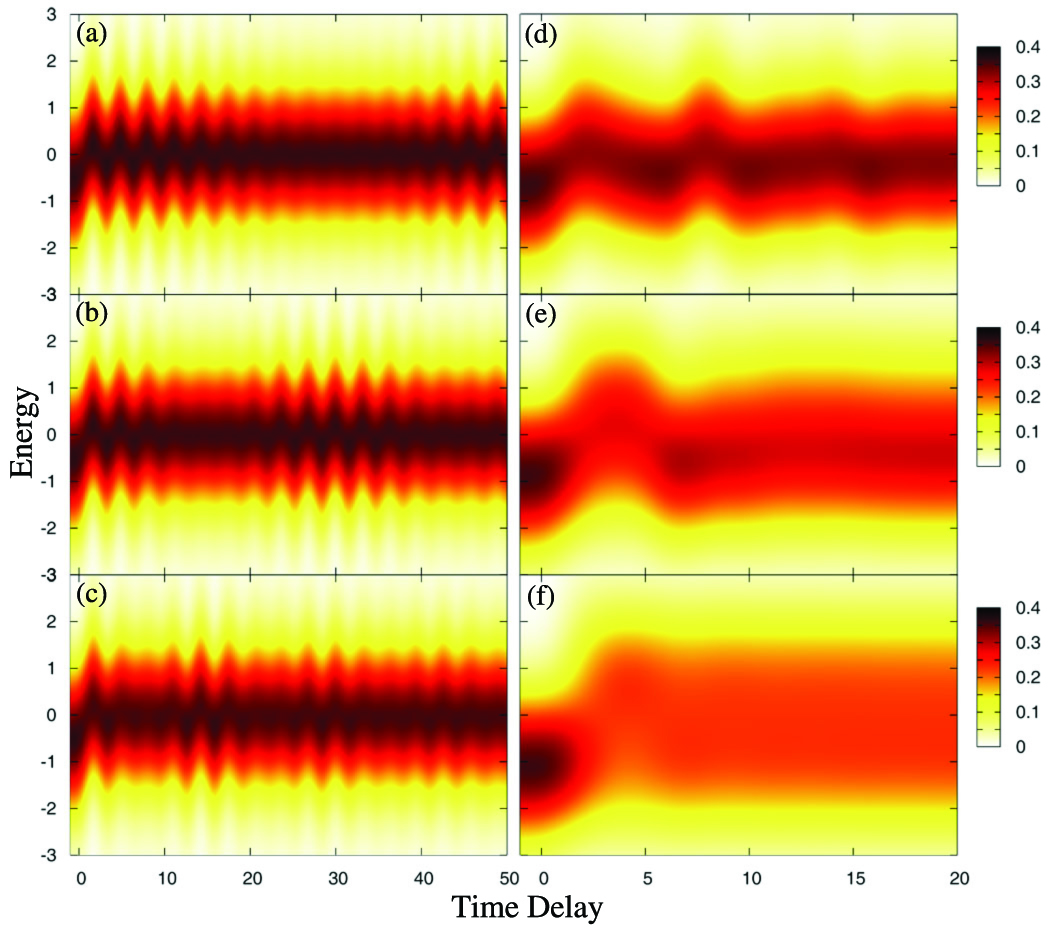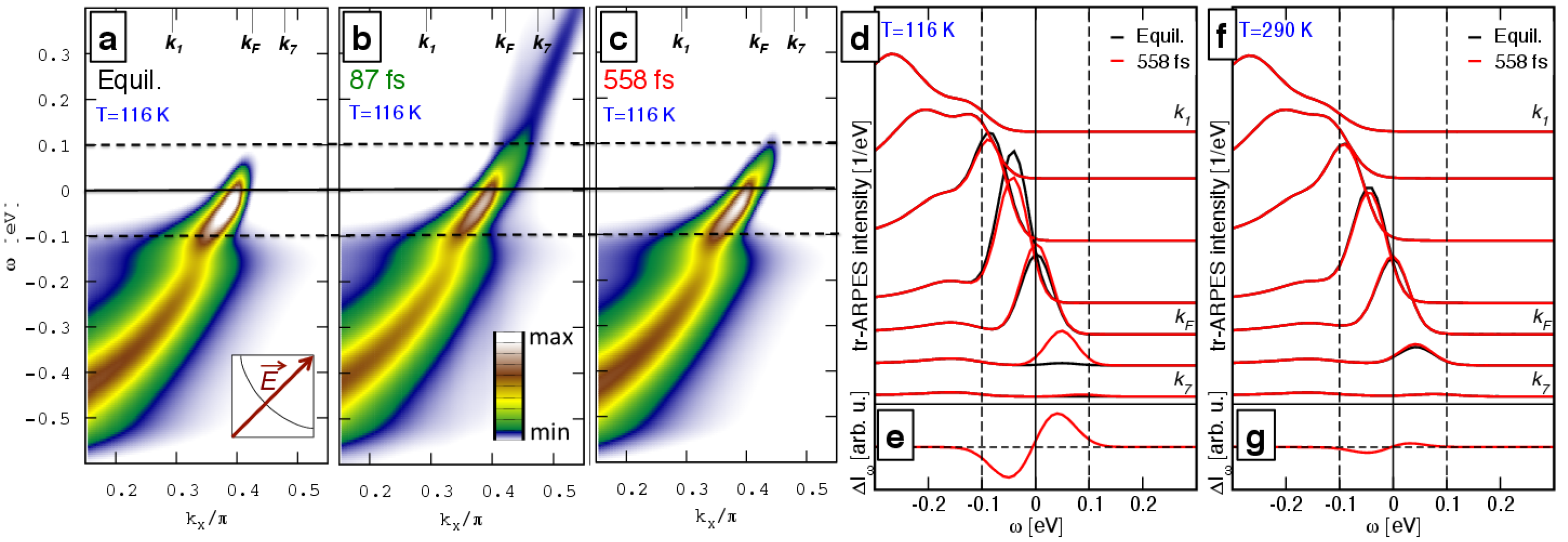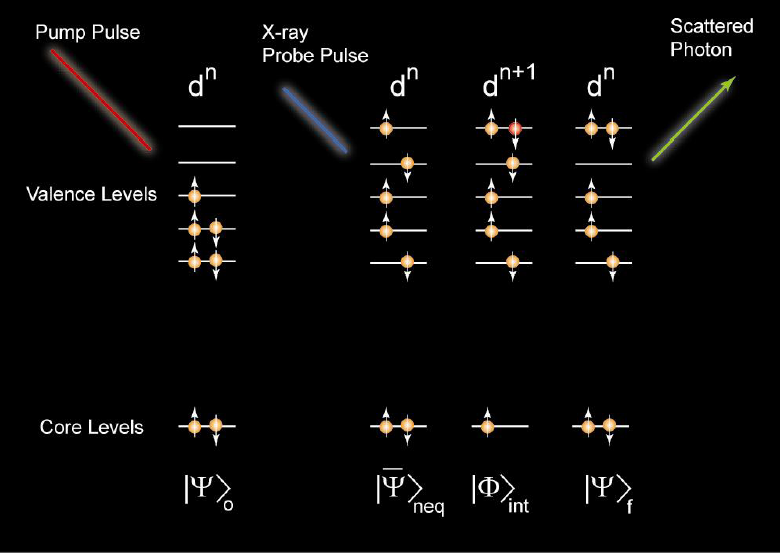
Research
The links will take you to internal pages about the the Devereaux Group research concentrations.
 |
Time Domain Spectroscopy |
Cartoon animation of a time-resolved pump-probe photoemission experiment. An initial, low energy (red) laser pulse excites the system followed by a higher energy (blue) laser pulse ejecting electrons detected by an electron analyzer. (Animation courtesy F. Schmitt)
Photoemission spectroscopy (PES) already provides valuable information about single-particle electron dynamics in condensed matter systems and the technique recently has been extended to the time-domain (tr-PES) using pump-probe, femto-second techniques. These experiments have been able to provide new information on electron dynamics directly in the time domain. One of the first successes involves collectively driving a system between two states of matter (charge density wave (CDW) state and normal state) and identifying characteristic frequencies in the temporal evolution of the spectral intensity. One of the first handful of experiments was conducted by our experimental collaborators and appears in a recent issue of Science. In the experiment, signatures of the CDW amplitude mode, a collective mode of the underlying charge modulation, were revealed directly in the temporal dynamics of the PES response. These experiments have revealed detailed information about the coupling between electrons and the underlying lattice; however, recent advances have extended the technique into the atto-second regime which opens the possibility of observing and controlling dynamics on time-scales relevant to correlated electron processes.
Most pump-probe experiments have been interpreted in terms of "hot" electrons, equilibrated at highly elevated, effective temperatures. This approach captures a redistribution of spectral intensity, but does not account properly for the rearrangement of accessible electronic states nor does it properly capture the nonequilibrium redistribution of spectral weight between these states that accompanies pump-pulses with the high excitation densities needed to drive phase transitions or excite electronic collective modes.
To directly address these issues in a controlled fashion, we have started to examine the time-domain response of a correlated electron system driven toward a nonequilibrium steady state by an intense DC field. We employ dynamical mean-field theory (DMFT) to study the nonequilibrium Keldysh boundary problem for the spinless Falicov-Kimball model at half-filling. Effects due to the finite temporal width of the photoemission probe-pulse with adjustable time delay are introduced by partially transforming the nonequilibrium double-time lesser Greens function to real frequency. The formalism was developed by our collaborators in a recent article.
 |
Panel of figures highlighting the tr-PES response for a given probe-pulse shape as a function of the Falicov-Kimball model interaction strength, (a)-(f). The final two panels, (e) and (f), show the response for a system on the insulating side of the Mott metal-insulator transition (MIT). Note the appearance of Bloch oscillations for weak interactions and an additional low frequency modulation proportional to the interaction strength. The systems approach a nonequilibrium steady state, but this is only apparent for fairly wide probe-pulses that effectively average the response over a wide temporal range.
We have extended these initial studies using our INCITE award at NERSC to study the time-domain response of the spinless Falicov-Kimball model subject to a time-dependent electric field. The code is an extension of the massively parallel code used to study the same hamiltonian with DC driving fields. It is a mature, MPI based code that has been tested on a number of different platforms and displays efficient scaling to thousands of processors. We initially used the Cray XT4 system Franklin to perform these numerical experiments and more recently have been using the Cray XE6 system Hopper. As results become available they will be posted here.
The method also can be used to gauge the relaxation of a pumped system back toward equilibrium by observing the evolution of the equal-time distribution function. The panels below show the distribution function, starting in equilibrium, through the application of the pump-pulse, and during relaxation. Each test case represents a different set of simulation parameters with the first two representing systems on the metallic side of the MIT and the third representing an insulating system. The system in case one has been pumped with a simple Gaussian waveform while the systems in test case two and three have been pumped by a modulated Gaussian waveform more representative of the pump-pulses used in experiment. Note that while the system attempts to return to an equilibrium-like distribution (at a higher effective temperature) in the metallic regime (Case 1) in the insulating regime, the system retains a nonequilibrium distribution of electrons even at long times following the pump-pulse. These distribution functions are plotted in "band energy" space rather than momentum space as described in this reference work.
Case 1: Evolution of the momentum distribution for a metallic system (U=0.5) pumped by a Gaussian waveform with an additional harmonic modulation (ω=0.5). Pump #2 refers to a sequence of different pump pulses simulated for these experiments.
Case 2: Evolution of the momentum distribution for an insulating system (U=2.0) pumped by a harmonically modulated Gaussian waveform as in the case above (ω=0.5). Pump #2 refers to a sequence of different pump pulses simulated for these experiments.
We have begun investigating the influence of additional degrees of freedom (primarily the lattice or phonons) on the relaxation dynamics in pump-excited electron systems. We use a very similar Keldysh approach to that described above to evaluate the evolution of the electron propagator as a function of time where the influence of the lattice degree of freedom is included via a simple Migdal approximation for the self-energy and we evaluate the contribution to the electron self-energy exactly using the lowest order electron-phonon diagram. Using this approximation, we can show that the dynamics of the phonon mediated recovery occurring at long times is controlled by the equilibrium self-energy as a function of momentum and frequency.
In this sequence we see the evolution of the change in the electron distribution in the first Brillouin zone and the subsequent recovery through the electron-lattice interaction. Notice the "fringes" associated with oscillations of the distribution whose frequency is related to the underlying phonon frequency.
 |
Panel of figures highlighting the tr-ARPES response for a given probe-pulse shape within the Migdal approximation for the electron-phonon interaction. Particular emphasis is placed on the apparent recovery of the system at long times and the fact that significant redistribution of spectral weight remains in the ARPES response within the window of the phonon frequency. The last two panels highlight the deviation between the measured response at long times at two different temperatures and that measured in equilibrium. These results are quite reminiscent of those appearing recently in Nature Physics on the time evolution of a pump excited cuprate superconductor from the experiments conducted by the Lanzara group.
We also are part of a Single Investigator and Small Group Research (SISGR) project devoted to the study of time-resolved soft X-ray scattering from condensed matter systems at the LCLS and ALS. The project combines experimental and theoretical studies designed around pump-probe X-ray scattering techniques. Here a THz or infrared laser pulse pumps the system out-of-equilibrium and an X-ray pulse, either from a synchrotron or free-electron laser (FEL) source, probes the system. Theoretically, we will attack this problem using the machinery we have developed for studying the X-ray scattering cross-section in equilibrium. Below is a schematic of the theoretical algorithm. We first solve the equilibrium problem to determine the equilibrium ground state and final states. The remaining steps require the evaluation of the time-evolution operator (or an approximation) associated with the pump-pulse to determine the nonequilibrium ground state, intermediate states, and final states as a function of pump-probe delay.
Our first article about experiments performed at the SXR beamline of the LCLS has recently appeared in Nature Communications. The article details the recovery of stripe-ordered Nickelate system following optical pump excitation. These findings provide a glimpse into the importance of phase fluctuations in the dynamics of nonequilibrium recovery following pump excitation and the striking contrast to the behavior observed in thermal equilibrium. The result is an important step forward in designing new strongly correlated novel materials for various applications.
 |
Schematic of the algorithm used to determine the tr-IXS cross-section. This schematic shows the steps for an L-edge IXS process where a core-hole/valence-electron pair (a hole in the Core Levels and an extra (red) electron in the Valence Levels) exists in the intermediate state. (Figure courtesy W.-S. Lee)
References and External Links
- A. P. Jauho and J. W. Wilkins, Phys. Rev. B 29, 1919-1938 (1984).
- J. K. Freericks, Phys. Rev. B 77, 075109 (2008).
- J. K. Freericks, H. R. Krishnamurthy, and Th. Pruschke, Phys. Rev. Lett. 102, 136401 (2009).
- B. Moritz, T. P. Devereaux, and J. K. Freericks, Phys. Rev. B 81, 165112 (2010).
- W. S. Lee et al, Nature Comm. 3 838 (2012).
Shen Laboratory: Time-resolved Spectroscopy
Ultrafast Surface Dynamics: Research Group of Prof. Martin Wolf
Uwe Bovensiepen Research Group
Lanzara Research Group
Max Planck Research Department: Structural Dynamics: Andrea Cavalleri
